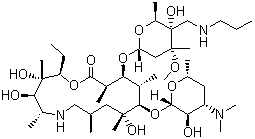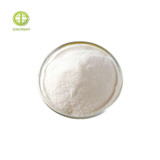Tulathromycin
-
- Category :
Pharmaceuticals and Biochemicals
- CAS NO : 217500-96-4
- EC NO :
- Molecular Formula : C41H79N3O12
- Main Specifications : 95% up, Vet-GMP
- Synonyms : (2R,3S,4R,5R,8R,10R,11R,12S,13S,14R)-13-[[2,6-Dideoxy-3-C-methyl-3-O-methyl-4-C-[(propylamino)methyl]-a-L-ribo-hexopyranosyl]oxy]-2-ethyl-3,4,10-trihydroxy-3,5,8,10,12,14-hexamethyl-11-[[3,4,6-trideoxy-3-(dimethylamino)-b-D-xylo-hexopyranosyl]oxy]-1-oxa-6-azacyclopentadecan-15-one;Tulathromycin;
Package: 25kg/drum
Uses : It is mainly used for the respiration of pigs and cattle caused by Actinobacteria, Mycoplasma, Pasteurella, and Haemophilus parahaemophilus.
Molecular Structure:

Product description:
Function of Tulathromycin
Tulathromycin is a newly marketed and animal-specific semi-synthetic macrolide antibiotic. It is mainly used for the respiration of pigs and cattle caused by Actinobacteria, Mycoplasma, Pasteurella, and Haemophilus parahaemophilus. System diseases. It has many advantages, such as low dosage, one-time administration, low residue and animal specific use. In my country, the most widely used macrolide drugs are tylosin and tilmicosin. Although these two drugs have achieved good results in production, with the prolonged use of time, many in my country Different levels of drug resistance have appeared in the region, leading to increasing dosages, but the therapeutic effect is gradually decreasing, and the efficacy of tyramycin is stronger than that of tylosin and tilmicosin, which are widely used in the market. Therefore, the use of tulathromycin in livestock and poultry production is very promising.
